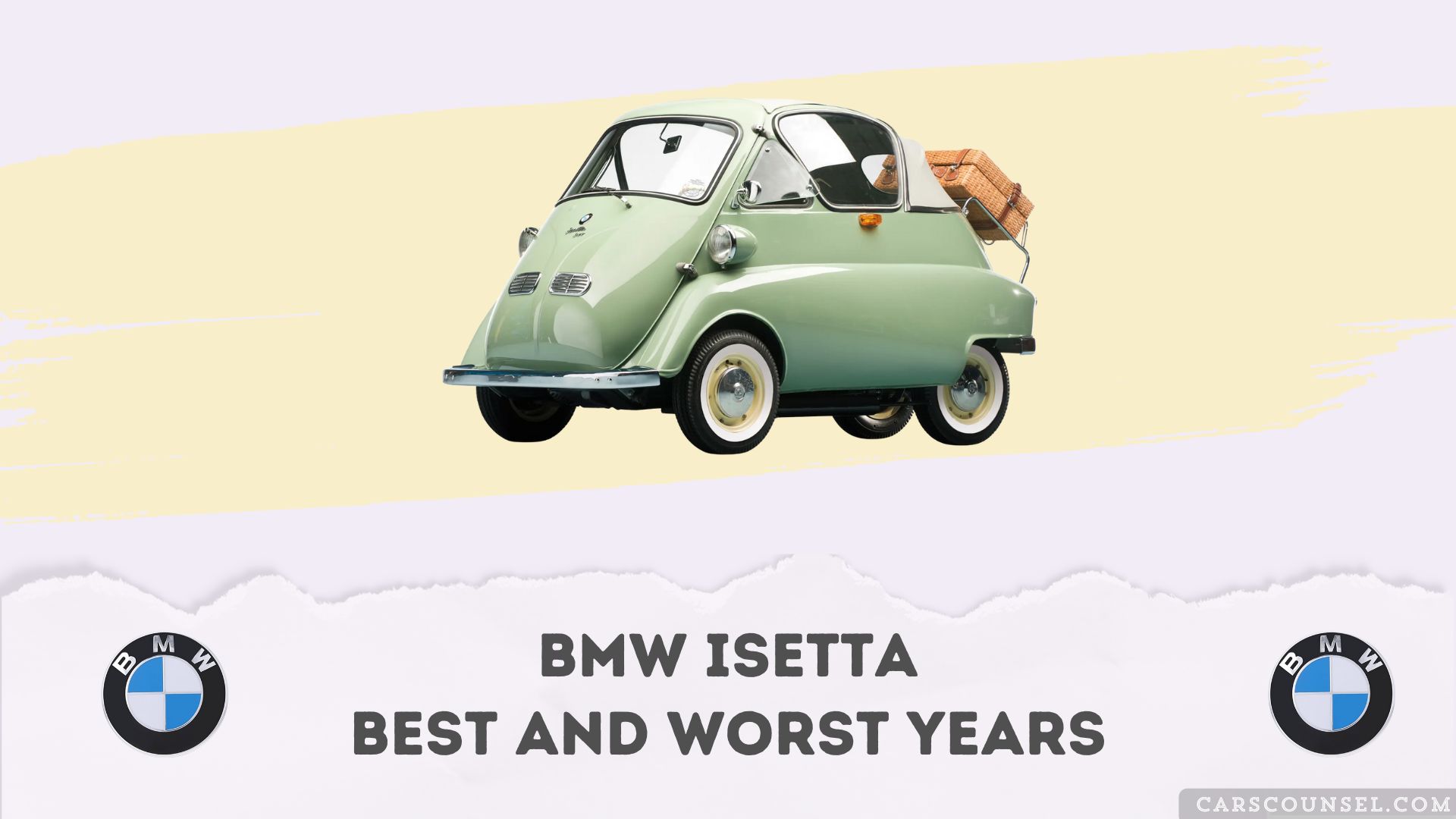The BMW Isetta is a microcar produced by BMW from 1955 to 1962. Based on the Italian Iso Isetta, BMW re-engineered the car with their own engine and design elements, making it a distinct model. This guide breaks down the best and worst years for the BMW Isetta based on reliability, performance, owner complaints, and long-term dependability. Information covers generational changes, common problems, year-by-year reliability, ownership costs, and key buying considerations.

Quick Navigation
BMW Isetta Generational Overview
Standard Isetta (1955–1957)
The first BMW Isetta model, introduced in spring 1955, used a 250 cc BMW motorcycle engine producing 12 horsepower. The car featured minor visual changes compared to the original Iso, with a focus on cost-effective production. Nearly 42,000 units were built before the next generation launched.
Isetta 300 (1957–1962)
In 1957, BMW upgraded the Isetta with a 300 cc engine, increasing power to 13 horsepower. This version retained the same body style but offered improved performance and reliability. Over 161,000 Isettas were built in total, with the 300 model being the most widely produced.
Best Years for the BMW Isetta
1957–1962 (Isetta 300)
The Isetta 300 generation is considered the most reliable, with fewer owner complaints and better engineering. The upgraded 300 cc engine offered improved mechanical strength and fewer failures compared to earlier models. Owners report fewer issues with brakes, suspension, and drivetrain, making these years the best for dependability.
Worst Years for the BMW Isetta
1955–1957 (Standard Isetta)
The early Standard Isetta models are known for more frequent mechanical issues, including brake lining failures, throttle and engine wear, and chassis/suspension problems. Owners frequently report poor braking performance and increased wear on key components due to the lower-powered 250 cc engine.
Common Problems Across the BMW Isetta Lineup
Engine Problems
Owners report engine stalls and starting issues, often due to fuel delivery or ignition problems. The one-cylinder engine is prone to overheating if the cooling fan or shroud is damaged.
Transmission Issues
The four-speed manual gearbox and chain drive require regular inspection for wear, especially in cars driven hard or with high mileage.
Electrical Faults
Electrical problems are not uncommon, especially in older models where wiring has degraded over time.
Rust Concerns
Rust affects the body, particularly the floor pan, battery compartment, and wheel wells. Poorly restored cars may have filled-in rust holes, so inspection is crucial.
Suspension or Steering Problems
Kingpins and steering components wear quickly, especially if the car was driven aggressively or not maintained regularly.
Reliability Breakdown by Year
1962 BMW Isetta 300 Reliability Rating
Final year with few reported issues, reliable engine, and improved durability.
1961 BMW Isetta 300 Reliability Rating
Similar to 1962, with strong owner feedback on dependability and fewer mechanical failures.
1960 BMW Isetta 300 Reliability Rating
Good reliability, common issues mainly related to aging components.
1959 BMW Isetta 300 Reliability Rating
Engine and drivetrain remain robust, but some electrical and brake issues may appear.
1958 BMW Isetta 300 Reliability Rating
Early 300 cc models show improvement over Standard Isetta, but some wear on suspension and steering.
1957 BMW Isetta 300 Reliability Rating
Introduction year of 300 cc engine, generally reliable but some early teething issues.
1956 BMW Isetta Standard Reliability Rating
More frequent mechanical failures, especially brakes and engine wear.
1955 BMW Isetta Standard Reliability Rating
Highest number of reported issues, including starting and running problems.
Warranty & Ownership Costs
Typical maintenance costs for a BMW Isetta are moderate for a classic car, with common repairs including brake work, engine overhauls, and rust repairs.
Warranty coverage for original models was limited, with no extended warranty available today for vintage vehicles.
Used buyers should budget for restoration and periodic major repairs, especially on older Standard Isetta models.
Buying Guide: What to Look For
Best Value Years: 1957–1962 (Isetta 300) offer the best balance of reliability and lower repair costs.
Years to Avoid: 1955–1957 (Standard Isetta) due to higher failure rates.
Key Components to Inspect: Engine, gearbox, kingpins, brake linings, and rust-prone areas.
Expected Mileage Thresholds: Most Isettas have low mileage, but high-use examples may require major work.
Known Trouble Spots: Cooling system, electrical wiring, and suspension components.
When looking at performance cars, make sure to check out our guides on models like the BMW I8, BMW 4 Series, BMW X4 and BMW X6. Knowing which model years to target and which to avoid is crucial. Our expert reviews break down these models, providing insights into the years that are celebrated for their engineering excellence and driving satisfaction, as well as those that are best to avoid due to potential issues.
FAQs
Is the BMW Isetta reliable?
The Isetta 300 (1957–1962) is generally reliable, but the Standard Isetta (1955–1957) has more frequent mechanical issues.
What year of the BMW Isetta is most dependable?
1957–1962 (Isetta 300) models are the most dependable, with fewer owner complaints and better engineering.
What year should you avoid?
Avoid 1955–1957 (Standard Isetta) due to higher failure rates and more common problems.
What are the most common problems?
Engine stalls, brake wear, rust, electrical faults, and suspension wear are the most common issues.
How long does a BMW Isetta last?
With proper maintenance, a BMW Isetta can last decades, but many require periodic major repairs due to age and use.
Conclusion
The BMW Isetta 300 (1957–1962) offers the best reliability and value, while the Standard Isetta (1955–1957) is best avoided due to frequent mechanical issues. Overall, the Isetta is a classic microcar with manageable maintenance costs and a loyal owner community, but buyers should inspect for rust, engine, and drivetrain wear before purchase.

